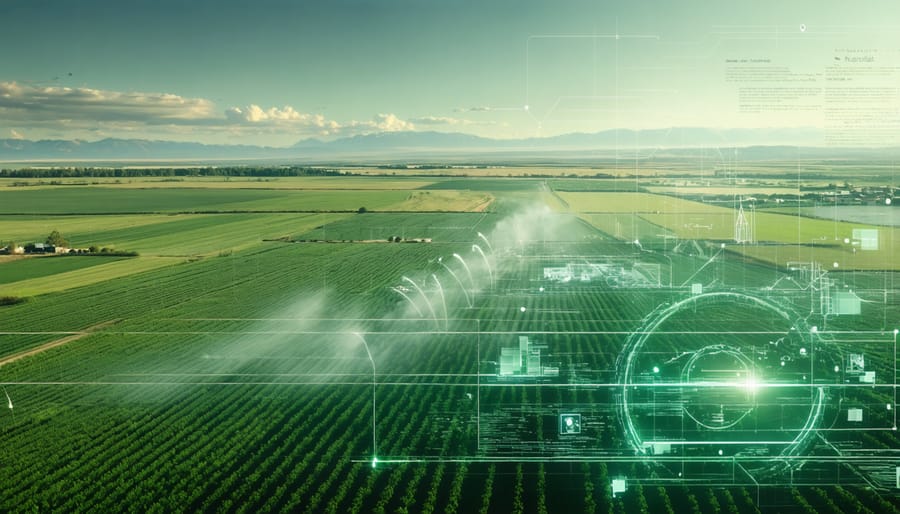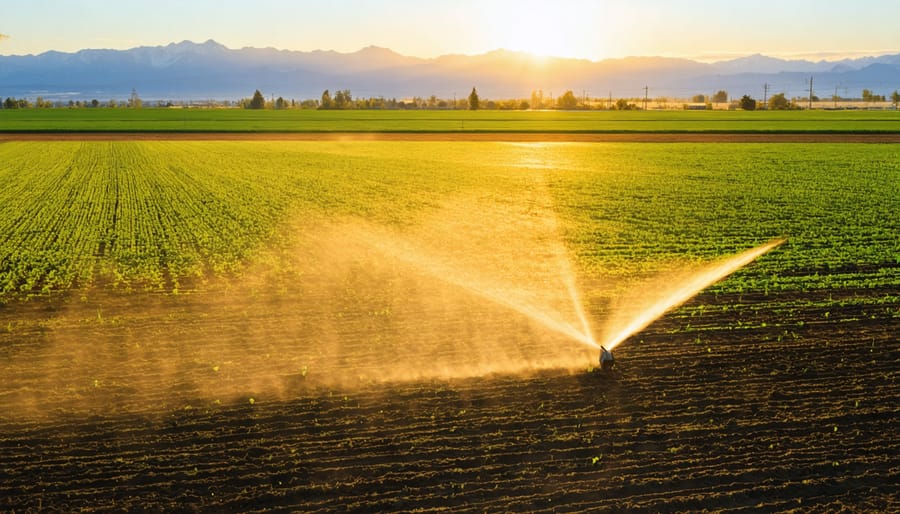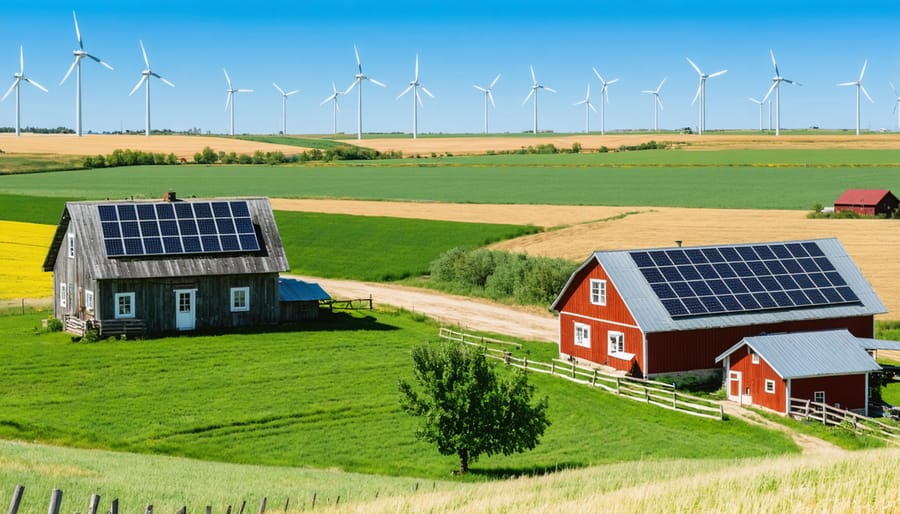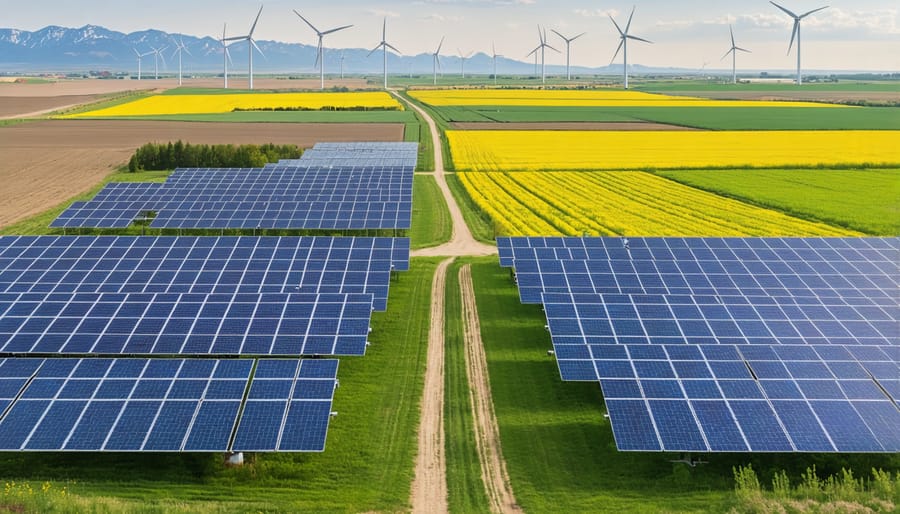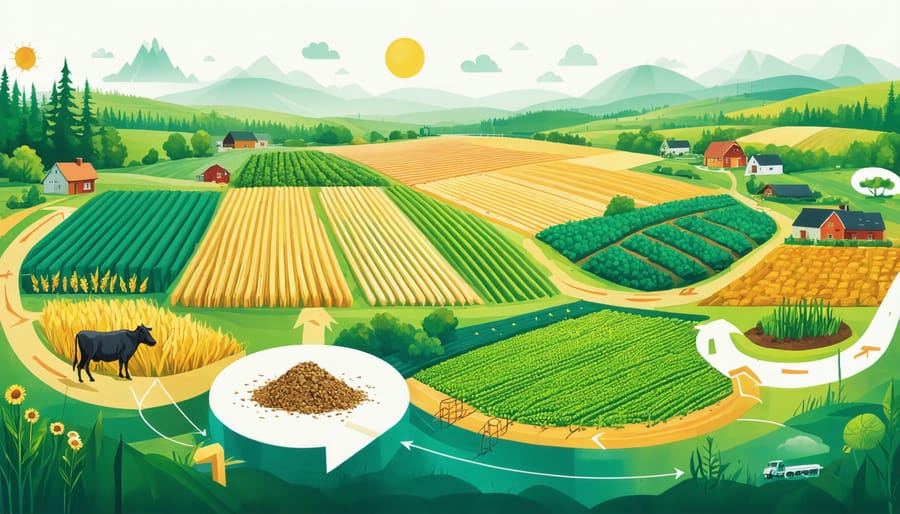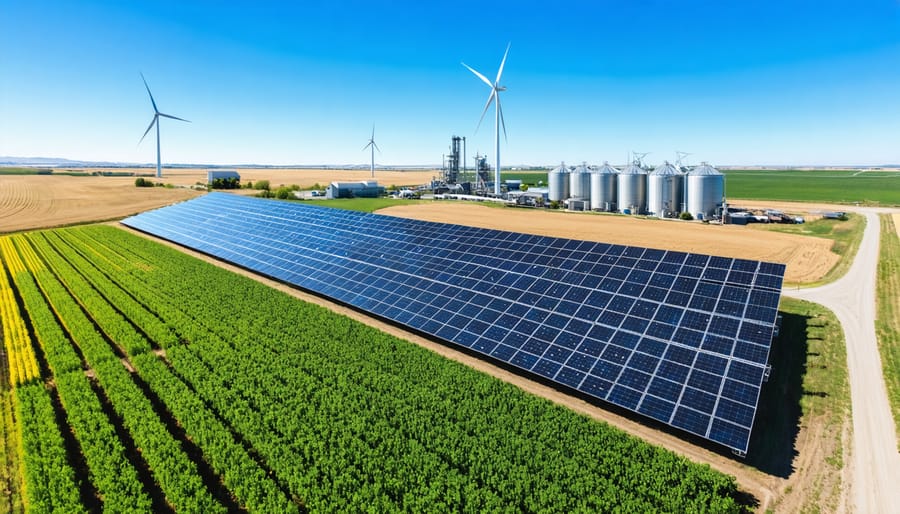Water stewardship stands at the crossroads of agricultural sustainability and economic viability for Canadian farmers. As Alberta faces increasing pressure on its water resources, innovative management strategies have become essential for maintaining productive farmland while protecting our vital watersheds. From the irrigation districts of Southern Alberta to the rain-fed regions of the north, farmers are pioneering water conservation techniques that combine traditional knowledge with cutting-edge technology.
Recent data from Agriculture and Agri-Food Canada shows that farms implementing comprehensive water management systems reduce their water consumption by up to 30% while maintaining or improving crop yields. These successes demonstrate how strategic water resource planning directly impacts both environmental sustainability and farm profitability.
Our agricultural communities are rapidly adapting to changing precipitation patterns and increased water demand through collaborative approaches. Whether it’s implementing precision irrigation systems, developing drought-resistant crop rotations, or participating in watershed management groups, Alberta’s farmers are leading the way in responsible water stewardship.
This transformation in water resource management isn’t just about conservation—it’s about building resilient farming operations that can thrive for generations to come while protecting one of our most precious natural resources.
Understanding Your Farm’s Water Needs
Water Audit Basics
Conducting a water audit on your farm is a straightforward process that can yield significant benefits for your operation. Begin by gathering your water bills from the past 12 months and documenting all water sources on your property, including wells, dugouts, and natural water bodies. Next, create a detailed map of your irrigation systems and water lines, noting key infrastructure points and potential problem areas.
Walk your property systematically, checking for leaks in pipes, damaged sprinkler heads, and signs of water pooling. Record your meter readings at the same time daily for a week to establish baseline usage patterns. For livestock operations, calculate daily water consumption per animal and compare it to industry standards.
Measure the flow rates of your irrigation systems using a flow meter or timed container method. Document water use for different farm activities, from crop irrigation to equipment washing. Consider seasonal variations and peak usage periods in your assessment.
Remember to involve your farm team in the audit process – they often have valuable insights about water use patterns and potential improvement areas. Use this collected data to identify opportunities for water conservation and efficiency improvements.
Seasonal Water Planning
Effective seasonal water planning starts with understanding your farm’s unique needs throughout Alberta’s distinct growing seasons. During spring thaw, focus on capturing and storing snowmelt through well-maintained dugouts and reservoirs. Consider installing soil moisture sensors to track water availability as temperatures rise.
Summer demands peak water management strategies. Implement irrigation scheduling based on crop type and growth stage, typically applying water during early morning or evening to minimize evaporation. Many Alberta farmers have found success with soil moisture monitoring systems that help optimize irrigation timing and reduce water waste.
Fall preparation is crucial for winter resilience. Ensure irrigation systems are properly winterized and consider installing snow fencing to maximize snow capture for spring moisture. During winter, monitor ice buildup in water storage facilities and maintain access points for livestock watering needs.
Keep detailed records of water usage patterns across seasons to identify trends and adjust your strategy accordingly. Connect with local watershed groups and agricultural extension services for seasonal forecasts and region-specific recommendations. Many successful farms in our region use weather monitoring systems integrated with their seasonal water management plans.
Smart Water Conservation Techniques
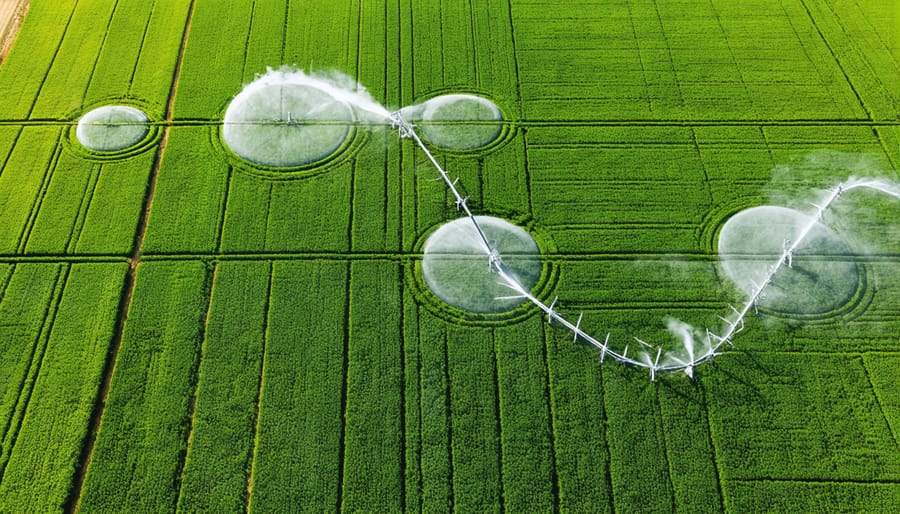
Efficient Irrigation Systems
Modern farming in Alberta has embraced smart irrigation technologies that significantly reduce water consumption while maximizing crop yields. Low-pressure pivot systems, soil moisture sensors, and weather-based controllers have become game-changers for local farmers, offering water savings of up to 30% compared to traditional methods.
Many Alberta farmers are implementing drip irrigation systems, which deliver water directly to plant roots through a network of tubes. These systems typically achieve 90% efficiency rates, compared to 65-75% for conventional sprinkler systems. Real-time monitoring through soil sensors helps farmers make data-driven decisions about when and how much to irrigate.
Variable Rate Irrigation (VRI) technology has gained popularity among larger operations, allowing farmers to adjust water application rates based on specific field conditions. This precision approach ensures that different soil types and crop varieties receive exactly what they need.
The Southern Alberta Irrigation Projects Association reports that farms using these efficient systems have reduced their water usage by an average of 100 millimetres per hectare annually. Additionally, these systems can be integrated with fertigation methods, delivering nutrients along with irrigation water for optimal resource use.
Local success stories include the Miller family farm near Lethbridge, which cut water usage by 25% after installing soil moisture sensors and implementing scheduled irrigation cycles based on real-time data.
Soil Management for Water Retention
Effective soil management is crucial for maximizing water retention on Alberta farms. By implementing proven soil health improvement techniques, farmers can significantly increase their soil’s water-holding capacity while reducing irrigation needs.
Adding organic matter through cover crops and crop residue management creates a sponge-like soil structure that captures and holds moisture. Many Alberta farmers have found success with minimum tillage practices, which preserve soil structure and natural water pathways. Incorporating composted manure at 10-15 tonnes per hectare can increase water retention by up to 20%.
Strategic mulching with straw or other organic materials helps reduce evaporation and maintain consistent soil moisture levels. Creating windbreaks and implementing contour farming techniques further protects soil from moisture loss due to wind and runoff.
Local success stories show that farms using these practices have reduced irrigation needs by 30-40% while maintaining or improving crop yields. These methods not only conserve water but also enhance soil fertility and promote long-term farm sustainability.
Drought-Resistant Crop Selection
In Alberta’s semi-arid climate, selecting drought-resistant crops is crucial for sustainable farming. Wheat varieties like AC Strongfield and AAC Brandon have proven particularly resilient, requiring 20-30% less irrigation than traditional varieties while maintaining good yields. These crops typically need only 300-400mm of water throughout their growing season.
Pulses, especially yellow peas and lentils, are excellent choices for water-conscious farming. Their deep root systems and natural nitrogen-fixing abilities make them both water-efficient and soil-enriching. Local farmers report successful yields with these crops using minimal irrigation during dry periods.
Drought-tolerant canola varieties, developed specifically for Prairie conditions, have shown promising results in recent field trials across Southern Alberta. These modified varieties can maintain oil content even with reduced water availability.
For sustainable diversification, consider hardy forage crops like sainfoin and alfalfa, which require minimal irrigation once established. Indigenous crops like quinoa and amaranth are gaining popularity among Alberta farmers, offering both drought resistance and market opportunities.
Remember to rotate these crops strategically to maximize soil moisture retention and maintain field health throughout the growing season.
Water Quality Management
Testing and Monitoring
Regular water quality testing is fundamental for successful farm management in Alberta. The key parameters you’ll want to monitor include pH levels (ideally between 6.5-8.5), total dissolved solids (TDS), and electrical conductivity (EC). For livestock operations, testing for bacteria like E. coli and coliform is essential, with samples recommended quarterly.
A basic testing kit should include pH strips, a TDS meter, and sampling bottles. Many Alberta farmers find success with monthly testing routines, increasing frequency during critical growing periods or after significant weather events. The Alberta Agriculture Water Quality Program offers subsidized testing services through approved laboratories across the province.
For irrigation systems, monitoring water pressure and flow rates helps detect issues early. Install pressure gauges at key points and keep detailed records of readings. Modern sensor technologies, while initially costly, can provide real-time data through smartphone apps, making monitoring more convenient and precise.
Consider joining local watershed monitoring groups, where farmers share testing resources and expertise. The Environmental Farm Plan program provides guidance on establishing monitoring protocols suitable for your specific operation. Remember to maintain detailed records of all test results – this historical data proves invaluable for tracking trends and making informed management decisions.
Regular monitoring also helps identify potential issues before they become problems, saving both time and resources in the long run.

Natural Filtration Methods
Natural filtration methods offer cost-effective and environmentally sound solutions for maintaining water quality on Alberta farms. Many local farmers have successfully implemented these sustainable approaches, combining traditional knowledge with modern innovations.
Riparian buffer zones, consisting of native plants and trees along waterways, serve as excellent natural filters. These zones trap sediments, absorb excess nutrients, and provide wildlife habitat. For example, the Marshall family farm near Red Deer has maintained a 30-metre buffer zone along their creek for over two decades, significantly improving their water quality while supporting local biodiversity.
Constructed wetlands are another powerful filtration tool gaining popularity among Alberta farmers. These systems mimic natural wetlands, using aquatic plants like cattails and bulrushes to filter water. They’re particularly effective for managing agricultural runoff and can be sized to suit properties of any scale.
Bioswales and rain gardens offer practical solutions for directing and filtering surface water. These landscaped depressions, filled with native vegetation and carefully selected soil mixtures, naturally filter pollutants while managing water flow. They’re especially useful near barns and high-traffic areas.
Sand and gravel filtration systems, when properly designed, provide excellent mechanical filtration for farm water supplies. Many Alberta farmers combine these with biological filtration methods for comprehensive water treatment. Regular maintenance of these systems is straightforward, typically requiring only seasonal checking and occasional material replacement.
These methods not only improve water quality but also enhance farm resilience and reduce dependence on chemical treatments.
Community-Based Water Management
Local Success Stories
Alberta’s farmers are leading the way in innovative water management solutions through inspiring community-based agricultural initiatives. The Bow River Irrigation District’s collaborative project stands out as a remarkable example, where local farmers partnered to implement a shared water monitoring system that reduced consumption by 25% over three years.
In Lacombe County, the Morrison family farm transformed their water usage through an innovative rainwater harvesting system. By installing strategic collection points and underground storage tanks, they now save approximately 1.5 million litres of water annually, while maintaining crop yields at optimal levels.
The Wheatland Conservation Area project demonstrates the power of collective action. Ten neighbouring farms joined forces to create interconnected wetland areas, improving water retention and reducing runoff. This initiative not only enhanced water efficiency but also created natural habitats for local wildlife.
In Mountain View County, the Peterson Brothers’ farm pioneered a precision irrigation system that uses soil moisture sensors and weather data to optimize water application. Their approach has been adopted by fifteen other local farms, creating a network of water-conscious producers who share data and best practices.
These success stories showcase how Alberta’s farming communities are working together to build resilient water management systems while maintaining productive agricultural operations.

Building Water Management Networks
Building effective water management networks starts with identifying common challenges and shared resources within your local farming community. Through collaborative resource management, Alberta farmers have successfully created resilient water-sharing systems that benefit entire agricultural regions.
Begin by connecting with neighbouring farms to discuss water needs and available resources. Consider forming a local water management committee that meets regularly to coordinate usage schedules and maintain shared infrastructure. Many successful networks in Southern Alberta started with just three or four farms working together on irrigation planning.
Establish clear communication channels through messaging groups or regular meetings. Document agreements about water allocation, maintenance responsibilities, and cost-sharing arrangements. Consider using digital tools to track water usage and schedule sharing times efficiently.
Partner with local agricultural extension offices and conservation authorities for technical support and funding opportunities. These organizations often provide valuable resources for network development and can help navigate regulatory requirements.
Remember to build flexibility into your agreements to accommodate seasonal variations and changing needs. Successful networks often include contingency plans for drought periods and emergency situations. Start small, focus on building trust, and gradually expand your network as systems prove successful.
Maintain regular network meetings to address concerns, share successful strategies, and adapt to changing conditions. This ongoing collaboration ensures the long-term sustainability of your water management system.
As we’ve explored throughout this article, effective water management is not just about conservation – it’s about building a resilient and sustainable future for Alberta’s agricultural community. The strategies we’ve discussed, from implementing precision irrigation systems to adopting drought-resistant crops, represent practical steps that every farmer can take to improve their water stewardship.
Remember that small changes can lead to significant results. Starting with soil moisture monitoring or participating in local watershed management groups are excellent first steps. Many Alberta farmers have already demonstrated that these practices not only conserve water but also improve crop yields and reduce operational costs.
The success stories we’ve shared from farms across the province show that sustainable water management is achievable and profitable. Whether you’re managing a small family farm or a large agricultural operation, there’s an opportunity to become a leader in water conservation within your community.
Looking ahead, the future of Alberta agriculture depends on our collective commitment to responsible water management. By working together, sharing knowledge, and implementing these proven strategies, we can ensure our farms remain productive for generations to come.
Take the first step today by assessing your current water usage and choosing one practice to implement this season. Remember, you’re not alone in this journey – our agricultural community and local extension services are here to support your transition to more sustainable water management practices.

